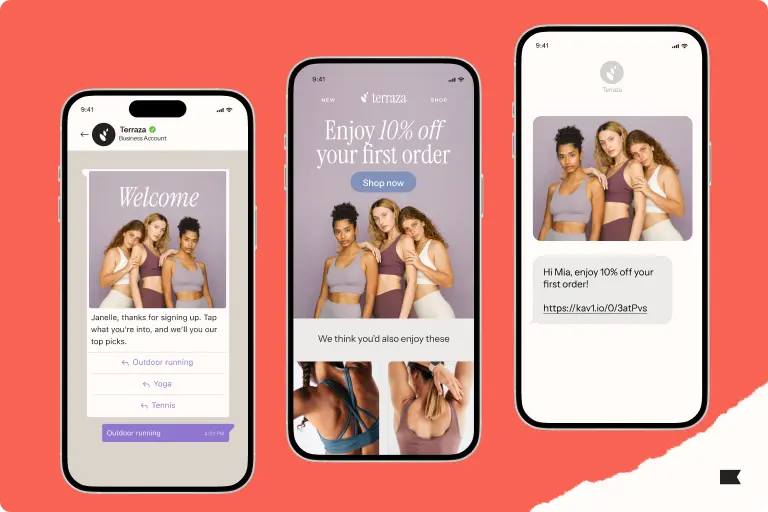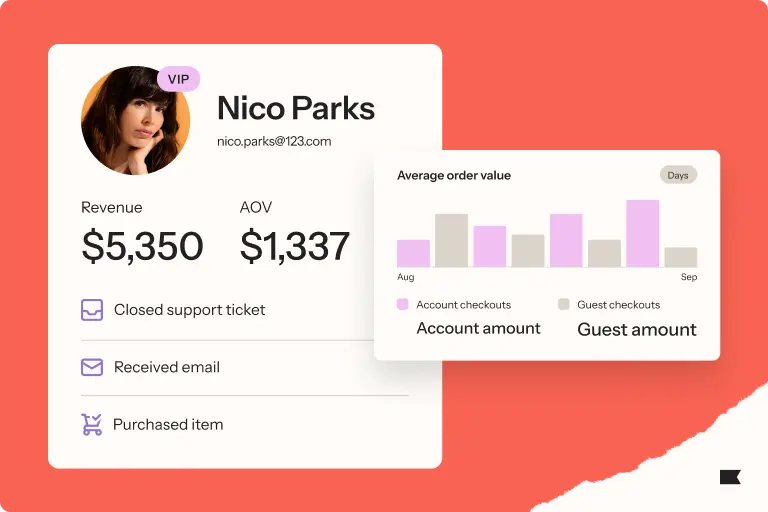You know, but they don’t: how to get executive stakeholders on board with adopting Klaviyo
Chances are, if you’re a marketer in the DTC industry, you’ve seen the results that Klaviyo produces for brands of all sizes. Maybe you’ve even been the one who helped drive those results at your previous company. And now, at your next professional venture, you see room for improvement in the digital relationships your brand is creating and nurturing.
Either way, you know that Klaviyo is the addition to your tech stack that will deepen your customer relationships and help you reach business KPIs. But how can you convince the stakeholders at your company that this is the right move?
Nobody makes purchasing decisions around software quickly, and for good reason.
An addition to your tech stack is a big commitment. Period. But one that’s as effective as Klaviyo is at boosting email and SMS revenue is something that you can confidently stand by.
Here are 5 steps to closing the gap between your team’s interest in Klaviyo and actually adopting it at your business.
1. Figure out what leadership wants
Let’s face it: people have their own agendas. In an ideal world, everyone’s goals align with the big picture. But when you get granular, it can sometimes feel like you’re in the same boat, rowing in different directions.
That’s why, when asking a stakeholder to consider an addition to your tech stack, seeing things from their perspective is important.
While your focus may be on the health of various automations and other day-to-day concerns, the person who will ultimately sign off on buying Klaviyo will likely be focused on questions that are more zoomed out, like:
- What are our specific goals around revenue growth?
- What are our specific revenue strategies over the next year?
- How will we evaluate the tool in question? By ROI? Price of the tool? Time savings? Something else?
Once you have clear answers to these questions, you can more easily articulate how Klaviyo can help you achieve your company’s goals.
2. Use your Klaviyo salesperson as a partner
“It sounds elementary, but a lot of people don’t realize how much we can take off their plate,” says Gabrielle Keeley, who leads a sales team at Klaviyo. “Personally, I’ve helped so many people move off of other marketing platforms. But this might be your first time ever trying to sell Klaviyo to leadership.”
A lot of people don’t realize how much we can take off their plate.
So, take a deep breath: the next step doesn’t have to be super labor-intensive. You don’t need to spend your nights and weekends quantifying your use case and building out pitch decks.
Those are the exact tasks a Klaviyo account executive can take off your plate. They’ll be happy to:
- Quantify your company’s use case based on where your metrics currently stand. You’ll share your brand’s AOV, current email conversion rate, and list size. Then, a sales rep will tell you what types of revenue lifts could be possible, and exactly how it would happen in Klaviyo.
- Create a business case unique to your company’s needs. The Klaviyo sales team is skilled and experienced at understanding executives’ needs. They can create a pitch deck—that you weigh in on—to address everything that’s on the minds of your executive stakeholders.
- Understand which evaluation criteria are important to decision makers. Is it increasing ROI? Consolidating other tools? Saving time? Knowing what factors are most important in the decision-making process will help you move things along.
Don’t be shy about starting a relationship with a Klaviyo sales rep early in your journey. They’re here to make the process easier.
“Our sales team can take a lot of the work off your shoulders to make for an efficient and easy process of evaluating and implementing Klaviyo,” says Michael Kurson, senior account executive at Klaviyo.
Our sales team can take a lot of the work off your shoulders to make for an efficient and easy process of evaluating and implementing Klaviyo.
3. Loop executive stakeholders in to a demo
Many executive stakeholders aren’t confident when it comes to buying software, and it’s not their fault. Even someone who regularly buys software might only make a purchase once or twice every 5 years.
While it may be tempting to play a game of telephone between salespeople and leadership, the best way to convince executive stakeholders of Klaviyo’s value is for them to see it for themselves.
Once you get to the demo stage, make sure to invite the following people:
- The CEO
- The CFO
- The CMO
- Any other stakeholder who would be able to give the purchase a hard yes or hard no
- The economic buyer: the person with ultimate authority over the purchasing decision
- Any other colleagues who would use it—email marketing managers, designers, SMS managers
Kurson shares that while you might be the “champion for Klaviyo” at your company, the sales team is poised to dialogue with your executive team directly and help you push Klaviyo through to approval by providing your team with relevant information, case studies, and personalized business cases.
While you might be the ‘champion for Klaviyo’ at your company, our sales team is poised to dialogue with your executive team directly.
4. Highlight flexibility with pricing
One of the key concerns your stakeholders will have in mind is flexibility. If you’re going to take this big step to add Klaviyo to your tech stack, how soon will you outgrow it and need a new solution?
The answer is never.
Klaviyo not only scales with you—meaning you won’t have to ride the merry-go-round of digital marketing solutions—but also offers flexible pricing.
Klaviyo’s pricing system meets your brand where you are, giving you enterprise functionality without line items, add-ons, or overages. You can go month to month on a credit card with no contract—or, if it’s a better fit for your business, you can opt for a contract instead.
One of the best parts of using Klaviyo is that it sets you up to keep your email list as clean as possible. That means you’ll never be paying for an oversized list that includes people who aren’t opening or engaging with your marketing messages. So, while we scale with you, we also help you keep your costs manageable.
5. Emphasize Klaviyo’s reporting and analytics
While you focus on how Klaviyo can help you action your marketing strategies, leadership is probably more concerned with how much money that strategy is generating for your company and how they can track that revenue accurately.
Klaviyo’s reporting and analytics make it easy to understand your metrics. With pre-built, customizable dashboards, you can visualize all your KPIs in one place. You can also schedule automatic reports to send to key stakeholders to make sure everyone stays informed.
Klaviyo adoption FAQs
Here are some frequently asked questions about adopting Klaviyo.
What should I think about when preparing to sell Klaviyo to leaders at my company?
We recommend getting a deep understanding of what your boss wants, leveraging the Klaviyo sales team as partners, looping all decision-makers in to a demo, and highlighting both Klaviyo’s flexibility and reporting.
Who should I invite to a Klaviyo demo?
Invite your CEO, CFO, CMO, any colleagues who would use Klaviyo, and whoever will be the ultimate decision maker.
Which aspects of Klaviyo should I emphasize?
Decision-makers tend to be most interested in Klaviyo’s flexible pricing, as well as our powerful reporting and analytics.

Related content

Klaviyo welcomes Chano Fernández as Co-CEO to help accelerate global growth and lead the next era of AI-powered customer experiences.

Discover how cross-channel marketing and the rise of SMS shaped BFCM 2025. Learn why email + text orchestration drove record engagement, efficiency, and revenue.

AOV stayed strong during BFCM 2025 despite rising prices. Learn why average order values held steady, what drove pricing power, and how brands can protect margins.